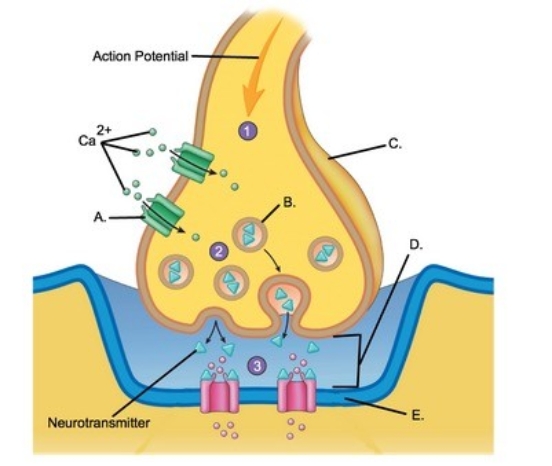A) An inflow of Na+
B) An inflow of K+
C) An inflow of Ca2+
D) An inflow of Cl−
E) An outflow of Cl−
G) A) and B)
Correct Answer

verified
Correct Answer
verified
Multiple Choice
Neurons arranged in a circular pathway form ________.
A) neuromotor junctions
B) temporal circuits
C) reverberating circuits
D) spatial pathways
F) None of the above
Correct Answer

verified
Correct Answer
verified
Multiple Choice
The gray matter of the cerebrum is composed of neuron cell bodies and makes up both the ________ and the ________.
A) cortex; deep cerebral nuclei
B) cortex; white matter
C) cerebral tracts; cortex
E) A) and C)
Correct Answer

verified
Correct Answer
verified
Short Answer
 -Identify structure "C" on the neuron.
A) Schwann cell
B) Node of Ranvier
C) Neuron cell body (soma)
D) Dendrites
E) Axon
-Identify structure "C" on the neuron.
A) Schwann cell
B) Node of Ranvier
C) Neuron cell body (soma)
D) Dendrites
E) Axon
Correct Answer

verified
Correct Answer
verified
Multiple Choice
Mr. Miller has been hospitalized for the flu. The flu virus increases membrane permeability to K+. You would expect his cells to ________.
A) depolarize
B) repolarize
C) isopolarize
D) hyperpolarize
E) hypopolarize
G) D) and E)
Correct Answer

verified
D
Correct Answer
verified
Multiple Choice
Identify the correct sequence of the structures as they are involved in activity at a chemical synapse.
A) Postsynaptic membrane; synaptic cleft; presynaptic terminal
B) Presynaptic terminal; synaptic cleft; postsynaptic membrane
C) Synaptic cleft; presynaptic terminal; postsynaptic membrane
D) Presynaptic terminal; postsynaptic membrane; synaptic cleft
F) A) and D)
Correct Answer

verified
Correct Answer
verified
True/False
Gray matter has little myelination, whereas white matter has abundant myelination.
B) False
Correct Answer

verified
Correct Answer
verified
Multiple Choice
There are ________ pairs of cranial nerves and ________ pairs of spinal nerves.
A) 10; 30
B) 31; 12
C) 12; 31
D) 30; 10
E) 12; 32
G) C) and E)
Correct Answer

verified
Correct Answer
verified
Multiple Choice
The central nervous system
A) is the site for processing information.
B) initiates visual and auditory stimuli.
C) consists of 43 pairs of nerves.
D) is totally involuntary.
E) does not interact with the peripheral nervous system.
G) B) and E)
Correct Answer

verified
Correct Answer
verified
Multiple Choice
A neuron that conducts pain sensations to the central nervous system would be classified as a/an ________.
A) motor neuron
B) sensory or afferent neuron
C) efferent neuron
D) association neuron
E) interneuron
G) D) and E)
Correct Answer

verified
Correct Answer
verified
Multiple Choice
The enteric nervous system consists of plexuses within the walls of the ________.
A) brain
B) spinal cord
C) digestive tract
D) urinary bladder
F) C) and D)
Correct Answer

verified
Correct Answer
verified
Multiple Choice
Gaps or interruptions in the myelin sheath are called ________.
A) internodes
B) tight junctions
C) neurofilaments
D) nodes of Ranvier
E) gap junctions
G) A) and E)
Correct Answer

verified
Correct Answer
verified
Multiple Choice
Why isn't an action potential transmitted from a postsynaptic membrane to a presynaptic terminal?
A) Presynaptic terminals have no acetylcholine receptors.
B) Presynaptic neurons do not have a resting membrane potential.
C) Acetylcholine can only diffuse in one direction across the synaptic cleft.
D) Synaptic vesicles in the postsynaptic membrane are inactive.
E) Acetylcholine is destroyed too quickly.
G) A) and C)
Correct Answer

verified
Correct Answer
verified
Multiple Choice
Which ion is necessary for the release of neurotransmitter from synaptic vesicles?
A) Cl−
B) Na+
C) K+
D) Ca2+
F) A) and D)
Correct Answer

verified
Correct Answer
verified
Multiple Choice
White matter is composed of
A) ganglial sheaths.
B) bundles of myelinated axons.
C) collections of nerve cell bodies.
D) bundles containing both myelinated axons and nerve cell bodies.
E) collections of unmyelinated axons.
G) A) and E)
Correct Answer

verified
Correct Answer
verified
Multiple Choice
The absolute refractory period ends when
A) inactivation gates of voltage-gated Na+ channels reopen.
B) activation gates of voltage-gated Na+ channels reopen.
C) the sodium-potassium pump stops.
D) voltage-gated K+ channels open.
E) None of the choices are correct.
G) B) and E)
Correct Answer

verified
A
Correct Answer
verified
Multiple Choice
Match the term with the correct definition. -Depolarization
A) Small change in the resting membrane potential confined to a small area
B) Charge difference across the plasma membrane when the cell is in an unstimulated state
C) Larger change in resting membrane potential that spreads over entire surface of a cell
D) Membrane becomes more positive when Na+ diffuse into cell
E) Return to the resting membrane potential
G) A) and C)
Correct Answer

verified
Correct Answer
verified
Multiple Choice
Which type of neuronal pathway allows for a stimulus to be transmitted to the most number of cells?
A) Divergent
B) Convergent
C) Reverberating
D) Both "Convergent" and "Reverberating" are correct.
F) All of the above
Correct Answer

verified
A
Correct Answer
verified
Multiple Choice
If a neuron is prevented from sending a neurotransmitter across a synapse to another cell, which neuron property is being inhibited?
A) Secretion
B) Excitability
C) Conductivity
D) Permeability
F) A) and D)
Correct Answer

verified
Correct Answer
verified
Multiple Choice
Neurons in the skin that are responsible for detecting pain are ________.
A) apolar
B) pseudo-unipolar
C) bipolar
D) multipolar
F) C) and D)
Correct Answer

verified
Correct Answer
verified
Showing 1 - 20 of 192
Related Exams